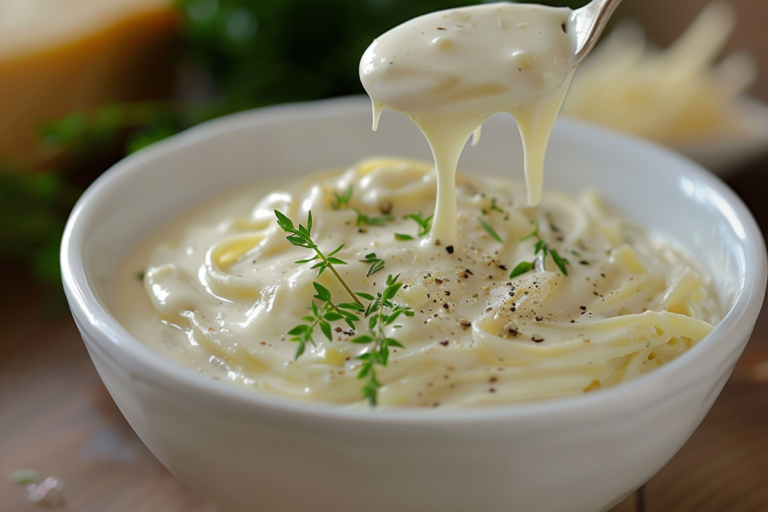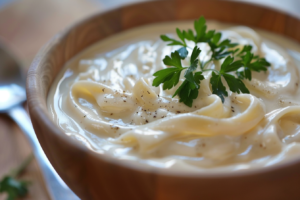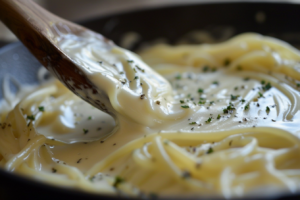Discover the Secrets of Alfredo Sauce
Alfredo sauce, a staple in Italian cuisine, has enchanted food lovers around the world with its rich and creamy texture. This article delves into what makes this beloved sauce a culinary treasure, from its classic ingredients to variations that cater to modern palates. Join us as we explore the traditional recipe, offer tips for perfecting your sauce, and answer some of the most common questions about Alfredo sauce.
Classic Homemade Alfredo Sauce Recipe
Alfredo sauce is more than just a condiment; it’s a luxurious addition to pasta that turns a simple meal into a gourmet experience. Let’s start with the basics: what is Alfredo sauce made of? At its heart, Alfredo sauce is a creamy blend of butter, heavy cream, and Parmesan cheese, often enriched with garlic to create a depth of flavor that is both simple and profound.
Ingredients Needed for the Perfect Alfredo Sauce
The magic of a great Alfredo sauce lies in its ingredients. Here are the essentials you’ll need:
- Butter: The base of the sauce, providing a rich flavor.
- Garlic: Adds a subtle kick and depth; use fresh for the best results.
- Heavy Cream: Creates the sauce’s signature creamy texture.
- Parmesan Cheese: Brings a salty, cheesy component that is indispensable.
Step-by-Step Cooking Instructions
Follow these steps to ensure your Alfredo sauce is velvety and delicious:
- Melt the Butter: Start by melting butter over medium heat, adding minced garlic once the butter is foamy.
- Add Heavy Cream: Pour in the cream and let it come to a gentle simmer, stirring occasionally.
- Stir in Parmesan: Remove from heat and blend in freshly grated Parmesan until the sauce is smooth.
Tips for a Flawless Sauce
To elevate your Alfredo sauce, consider these tips:
- Quality Matters: Opt for high-quality ingredients. Fresh, locally-sourced garlic and authentic Parmesan can make a significant difference.
- Keep It Gentle: Cook the sauce on a low heat to prevent the dairy from separating.
- Stir Well: Consistent stirring ensures an even texture without clumps.
Nutritional Information
While indulgent, it’s good to keep in mind the nutritional aspects of Alfredo sauce:
- Calories: Approximately 500 kcal per serving, making it a richer choice.
Equipment and Serving Suggestions
To make Alfredo sauce, you’ll need a few basic kitchen tools and the right serving approach:
- Saucepan: A medium saucepan is perfect for combining ingredients evenly.
- Whisk: Helps to integrate the Parmesan smoothly without lumps.
Alfredo sauce pairs wonderfully with fettuccine for a classic Fettuccine Alfredo or can be drizzled over steamed vegetables for a comforting meal. Remember, the secret to a great Alfredo is in the simplicity of its ingredients and the care with which it is prepared.
The Origin and Evolution of Alfredo Sauce
Alfredo sauce has a rich history that enhances its allure, tracing back to early 20th-century Rome. The original Alfredo sauce was much simpler than many versions available today, consisting mainly of butter and Parmesan, tossed with pasta. Let’s explore how this simple dish became an international sensation and how it has evolved over the years.
Historical Background of Alfredo Sauce
The sauce owes its name to Alfredo di Lelio, who featured the sauce at his restaurant in Rome to entice more customers. The original recipe was a double-rich combination of butter emulsified with Parmesan, added to pasta directly. It became famous when Hollywood stars visiting Rome spread the word about this luscious, creamy pasta dish.
Table: Timeline of Alfredo Sauce
| Year | Event |
|---|---|
| Early 1900s | Alfredo di Lelio invents the original sauce in Rome. |
| 1920s | Hollywood stars help popularize the dish internationally. |
| 1950s | Alfredo sauce variations begin appearing in cookbooks outside Italy. |
| 1980s | Cream is added to the sauce in American versions to enhance richness. |
| Today | Alfredo sauce is a staple in Italian-American cuisine, with numerous variations worldwide. |
Evolution and Variations
Over the years, chefs around the world have adapted the original Alfredo recipe, adding ingredients such as cream, garlic, and even proteins like chicken and shrimp to cater to local tastes. These additions have transformed it from a Roman specialty into a global comfort food favorite.
Table: Common Variations of Alfredo Sauce
| Ingredient Addition | Description | Common in Cuisine |
|---|---|---|
| Heavy Cream | Adds richness and creaminess to the sauce. | American |
| Garlic | Introduces a sharp, aromatic element. | Global |
| Chicken or Shrimp | Provides protein, making the dish more substantial. | American and Global |
Maintaining Tradition Amidst Innovation
While Alfredo sauce has undergone numerous changes, the core elements—simplicity and quality ingredients—remain unchanged. This blend of tradition and innovation ensures that Alfredo s. continues to be loved worldwide, demonstrating the power of culinary adaptability.
Exploring the origins and transformations of Alfredo s. not only provides a deeper appreciation of the dish but also reflects broader trends in global cuisine. As we continue to experiment and innovate, Alfredo s. serves as a reminder of how a simple dish can evolve into a beloved classic through creativity and cultural exchange.


